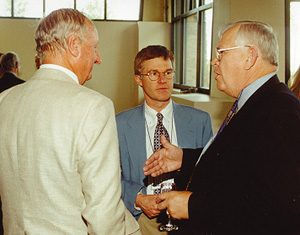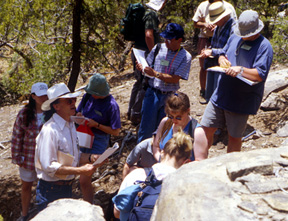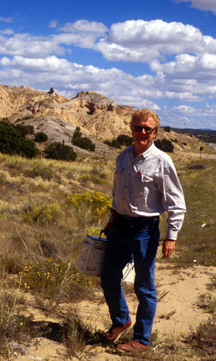geotimesheader
Society
Page
News about
people and
announcements
from
AGI's 35
member societies
______________________ |
To
post news in Society Page, send e-mail to geotimes@agiweb.org
with the subject: Society Page. |
Contents:
Biogeoscience
at AGU
The last two meetings of the American Geophysical Union (AGU) have highlighted
studies in astrobiology, the biogeochemistry and biogeophysics of terrestrial
and aquatic systems, land-atmosphere interactions, and planetary ecosystems.
During its spring meeting in Washington, AGU’s governing council voted
unanimously to add Biogeoscience as its 11th section — the first new section
since Solar-Terrestrial Relationships, later renamed Space Physics and
Aeronomy, was added more than 30 years ago.
“Many of the questions that are prominent in earth science now require
a more holistic understanding of the earth system, or of given environments,”
says Diane McKnight of the University of Colorado in Boulder and acting
president of the biogeosciences section. “This requires a more rigorous
integration of biological, geophysical and geochemical processes.” Such
linkages are critical, she says, in anticipating how conditions of coastal
circulation and river inflow lead to the development of hazardous algal
blooms like Pfisteria in estuaries along the East Coast or for searching
for signs of life in the solar system.
The new section should draw scientists involved in a range of biological
studies in earth and planetary sciences and promote interactions. “This
new section may increase the awareness of relevant work being published
in journals that many AGU members do not usually read,” McKnight says.
In addition, more biogeoscience researchers may submit their work to AGU
journals, such as JGR Planets for astrobiology and Water Resources Research.
“In general, as more scientists from biological sciences become involved
in AGU meetings, there may be more exchange of ideas and new interdisciplinary
proposals or programs developed.”
Biogeoscientists contributed more than 500 oral presentations and posters
at AGU’s latest fall and spring meetings. The section begins with around
360 members, some transferring from other AGU sections. But because creations
of new sections are rare, AGU statutes do not allow for special elections
for new officers. The biogeosciences section will not have voting representatives
on the council until the next regular election in 2002.
Fresh paint
and a new face
The Society of Economic Geologists (SEG) opened the doors of its new
international headquarters building in Littleton, Colo., June 10 during
a dedication ceremony that drew about 200 people. The building is seen
as the foundation for the society’s future and will be headed by the society’s
new executive director, Brian Hoal.
Planning for the building began in 1996 when an anonymous donor provided
an initial grant of five Berkshire Hathaway shares worth $169,000. Groundbreaking
took place in December 1998 and construction was completed in March 2000.
With the wet paint drying, John Thoms decided to retire from the volunteer
but full-time position of executive director. In April the SEG executive
committee chose to employ Hoal, a Namibian national, as Thoms’ successor.
| The headquarters will be the springboard for future international coordination
and expansion, as well as a focal point for SEG membership, Hoal says.
With three of every four new members from outside the United States, the
society must maintain communication between geographically dispersed members
and must coordinate activities in cost-effective ways. The building’s location
puts it close to international geoscience societies based in Denver and
to several centers of geoscience education.
Hoal relocated to Colorado in 1996 and set up a consulting partnership
with emphasis on southern Africa. While continuing an active consulting
career involved with exploration for gold, diamonds and base metals, he
completed an MBA degree at the University of Denver. Hoal also has experience
with new buildings. As director of Namibia’s Geological Survey in 1992
he became closely involved with the design and construction of one to help
expand the Namibian minerals industry. Similarly, the SEG headquarters
“marks the pinnacle of the society’s success in promoting the study of
mineral deposits,” Hoal says.
|

Brian Hoal,
SEG executive director (center), at the dedication
ceremony of
the society's headquarters building. He talks with
Brian Skinner
(left), president of Economic Publishing Co., and
A.J. Erickson
Jr. (right), SEG foundation trustee. |
The headquarters will operate with nine members of staff serving, together
with more than 17 volunteer committees, a membership of about 3,300 in
71 countries. “SEG’s success is its cohesion through focus and sharing,
excitement through discovery twice, first scientific and then mineral deposits,”
said Sam Adams, a past president of SEG. “This glorious home can do nothing
but solidify and enhance that success.”
High marks
for Santa Fe summer camp
| The month-long Summer of Applied Geophysical Experience (SAGE) at the
Department of Energy’s Los Alamos National Laboratory in New Mexico redefines
the meaning of summer camp. Students, often in their junior years in college
or recent graduates earning their doctorates, learn the ropes of real-world
exploration geophysics.
“Most of the students who go through SAGE end up working for oil and
gas industries,” says Scott Baldridge, co-director of SAGE along with George
Jiracek of the Department of Geological Sciences at San Diego State University.
“More and more of them are working for environmental companies and geoengineering
companies,” Baldridge says. |

Scott
Baldridge (lower left) discussing rock exposure with
students.
Courtesy of George Jiracek. |

George Jiracek deploys
geophysical equipment
in northern New Mexico.
Courtesy of George
Jiracek. |
In early August the two directors of the summer program received congratulations
for their efforts. The Society of Exploration Geophysicists awarded Baldridge
and Jiracek the society’s Special Commendation Award at its annual meeting
in Calgary, Alberta, Canada. “It makes us feel good for the tremendous
amount of effort that SAGE takes,” says Baldridge, who has worked at Los
Alamos since 1978 and has co-directed SAGE for 13 years. “It really is
an endorsement to Los Alamos and the National Science Foundation, which
also helps with money. It’s industry saying that this kind of activity
is important and they value it.”
Since SAGE started at Los Alamos in 1983, nearly 450 students from around
the world have completed the program. Students using such tools as Vibroseis
trucks and ground penetrating radar conduct seismic, electromagnetic and
gravity studies near the Santa Fe River Canyon and search for subsurface
pipes and other utility infrastructure at a site west of Los Alamos Airport.
“I always start the session with a Hawaiian challenge: ‘’A’a i ka hula,’
which means dare to dance,” Jiracek says. “At SAGE that means if the student
has already worked in gravity the challenge is to learn something like
electromagnetics.” The students have four weeks of complete immersion into
their topics and only two official days for rest and relaxation. Many students
this summer indicated an interest in teaching, including high school, Jiracek
said. |
Associate Editor Christina Reed compiles
Society Page.



